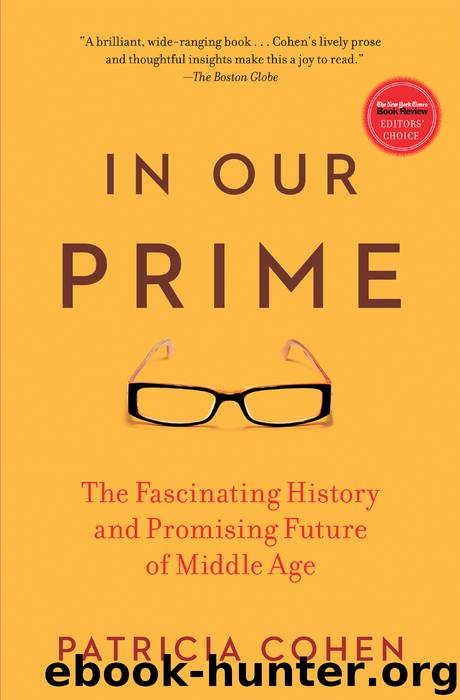In Our Prime by Patricia Cohen

Author:Patricia Cohen
Language: eng
Format: epub, mobi
Publisher: Scribner
Published: 2012-09-10T04:00:00+00:00
The Middle-Aged Brain and Intelligence
Until the twenty-first century, the prevailing view was that mental decline started in midlife. There were reasons to think so. At around 40, the brain, with its 100 billion neurons, begins to shrink in both weight and volume by about two percent every decade. The ventricles, which contain the fluid that surrounds and cushions each part of the brain, protecting it from knocks and jolts the way an amniotic sac cradles a fetus, grow larger as gray matter disappears. At the same time, the spaces or fissures between the undulating grooves on the brain’s thin outer layer become more defined. Connections between neurons thin out like male-pattern baldness, and the synapses—the places where neurons fire chemical transmitters—become increasingly sparse. The flow of blood and oxygen to the brain also begins to contract ever so slightly. Across the brain’s white matter—those bundles of nerve cell transmitters that are wrapped and insulated in a fatty molecule called myelin—small lesions can sometimes appear. Myelin itself can deteriorate and the brain’s ability to repair the DNA inside weakens. Most vulnerable of all is the prefrontal cortex, the brain’s executive office, where high-level planning and organization of complex behaviors take place.
Such physical alterations sound ominous and seem to point to irrevocable loss. But that is far from the whole story. If mental agility declines with age, why then is wisdom, one of the most valued measures of brain functioning, consistently associated with old age?
Scientists began questioning assumptions about aging and mental decline in the late 1920s and early 1930s. Edward Lee Thorndike, a psychologist who helped found the modern field of educational psychology, was one of the first to challenge conventional thinking about declining brainpower. Drawing on his experience with testing subjects for the U.S. military in World War I, Thorndike later conducted research on adult learning, asking people between 14 and 50 to perform different tasks like memorizing passages of poetry. He concluded that there were no meaningful differences in the abilities of 25- and 45-year-olds, the early years of middle age.
In the 1970s, a handful of psychologists pointed out that conclusions about aging and mental losses were often based on the frailest and most impaired segment of the population, the five percent of elderly people who lived in nursing homes. Like the originators of the MIDUS strategy, they decided to examine what extra abilities might accompany aging instead of searching only for deficits—to look at the half of the glass that was full.
Other studies had design flaws. Some differences in test results between younger and older adults were due to the particular vocabulary used on an exam or a familiarity with certain professions rather than with age. Testing memory in the elderly and college students by asking them to remember pairs of nonsense words skewed against older people. Students, accustomed to competing in all sorts of tests, were keen to do well, while the elderly were not especially motivated to work hard to remember meaningless terms.
A more fundamental problem
Download
This site does not store any files on its server. We only index and link to content provided by other sites. Please contact the content providers to delete copyright contents if any and email us, we'll remove relevant links or contents immediately.
50 After 50 by Maria Leonard Olsen(1697)
The Middle Passage: From Misery to Meaning in Midlife by James Hollis(1658)
Dirt by Bill Buford(1649)
1610396766 (N) by Jo Ann Jenkins(1641)
Manipulation: A Guide to Mind Control Techniques, Stealth Persuasion, and Dark Psychology Secrets by Deborah Weiss(1483)
The Age of Miracles by Marianne Williamson(1468)
Persuasion: Learn Techniques in Manipulation, Dark Psychology, NLP, Deception, and Human Behavior by Tori Dasani(1445)
Between Them by Richard Ford(1295)
Secret Life of the Grown-Up Brain by Barbara Strauch(1256)
Love and Trouble by Claire Dederer(1250)
Finding My Badass Self by Sherry Stanfa-Stanley(1247)
The Minimalist Mindset: The Practical Path to Making Your Passions a Priority and to Retaking Your Freedom by Danny Dover(1216)
I Miss You When I Blink: Essays by Mary Laura Philpott(1204)
In Our Prime by Patricia Cohen(1152)
A History of the Popes: Volume II: Middle Ages to the Protestant Reform by Wyatt North(1148)
The Change by Germaine Greer(1137)
Fear of Fifty by Erica Jong(1116)
The Art of Not Falling Apart by Christina Patterson(1105)
Your Story Matters by Leslie Leyland Fields(1084)
